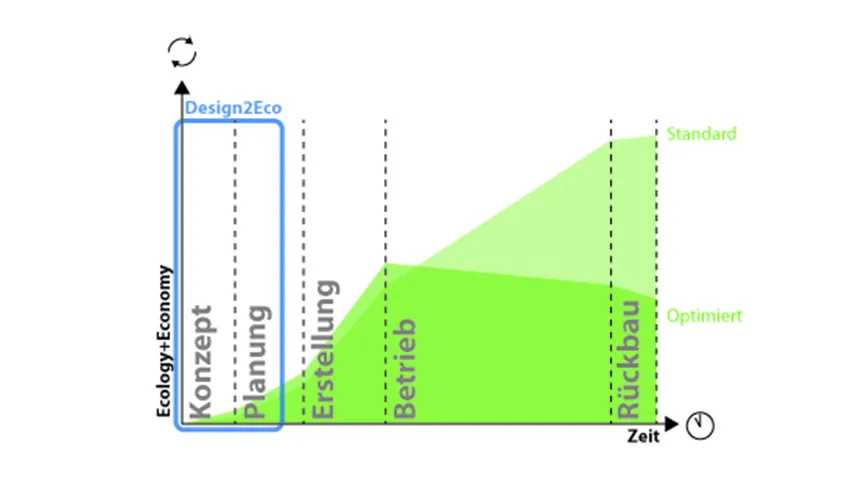Design2Eco
Design2Eco: Life Cycle Analysis in planning processes of office and administration buildings - decision criteria and optimisation possibilities in early planning phases

Project duration
01/2017 - 11/2018
Funding organization
Federal Ministry for the Environment, Nature Conservation and Nuclear Safety (BMUB)
Federal Institute for Research on Building, Urban Affairs and Spatial Development (BBSR)
Research Initiative Zukunft Bau
Project partners
ATP Sustain GmbH
Stiftung Bayerisches Baugewerbe
BayWa AG
Summary
Building design has been transformed since the concept of sustainability became established in the construction sector. The classical design requirements such as functionality, structural quality and aesthetics have been broadened to include energy efficiency, resource conservation and protecting the foundations of life for future generations. The pivotal decisions for optimising these varied goals are taken in the very initial stages of basic research and preliminary drafting. It is crucial to compile information early regarding the environmental impact and costs arising at all future life stages of a building in order to create the best possible basis for decision-making. Today, however, most decisions are based on investment costs. Design2Eco develops a comparative method of life cycle assessment in order to help ascertain the ecological and economic quality of a construction project at the early design stages. This opens up the way to innovative solution strategies that would otherwise not be applied in the conventional short-term view.
Design2Eco aims to develop a simple methodology for simultaneous assessment of the environmental impact and costs throughout a building’s life cycle, based on the example of office buildings, in order to assist a construction project’s stakeholders in decision-making at the early design stages. This methodology is being developed based on the experience gained in research projects carried out at the Institute of Energy Efficient and Sustainable Design and Building (ENPB) of the Technical University of Munich (TUM), together with projects recently completed by the ATP group.
The research focuses on the following topics:
- Which decisions made in the early stages of the design process (basic research, preliminary draft) have a profound influence on the overall ecological and, respectively, economic assessment of a building?
- How can we create comprehensible decision-making bases with a practical orientation for estimating the long-term qualities of different building variants?
- How can building variants’ lifecycle costs and environmental impacts be amalgamated in order to simultaneously optimise both criteria at the early design stages?
- How can we keep refining and improving the developed methodology based on experience gained in ongoing projects?
Neither the ecological impact nor the economic quality spanning the entire lifecycle of a building are presently embedded in the design process. Subsequent calculations are not helpful towards optimisation, given that no variants are analysed. The envisaged research project provides benchmark values based on the analysed projects, enabling stakeholders to assess and influence the overall effects at an early stage. The aim is a practice-orientated instrument for optimising buildings in terms of their long-term ecological and economic quality.
Project team
Dipl.-Ing. Patricia Schneider-Marin, Architect
Dipl.-Ing. (FH), Christina Meier-Dotzler, M.Eng.
Dipl.-Ing. Christine Röger, Architect
Klara Meier, M.Eng.
Dipl.-Ing. Jens Glöggler